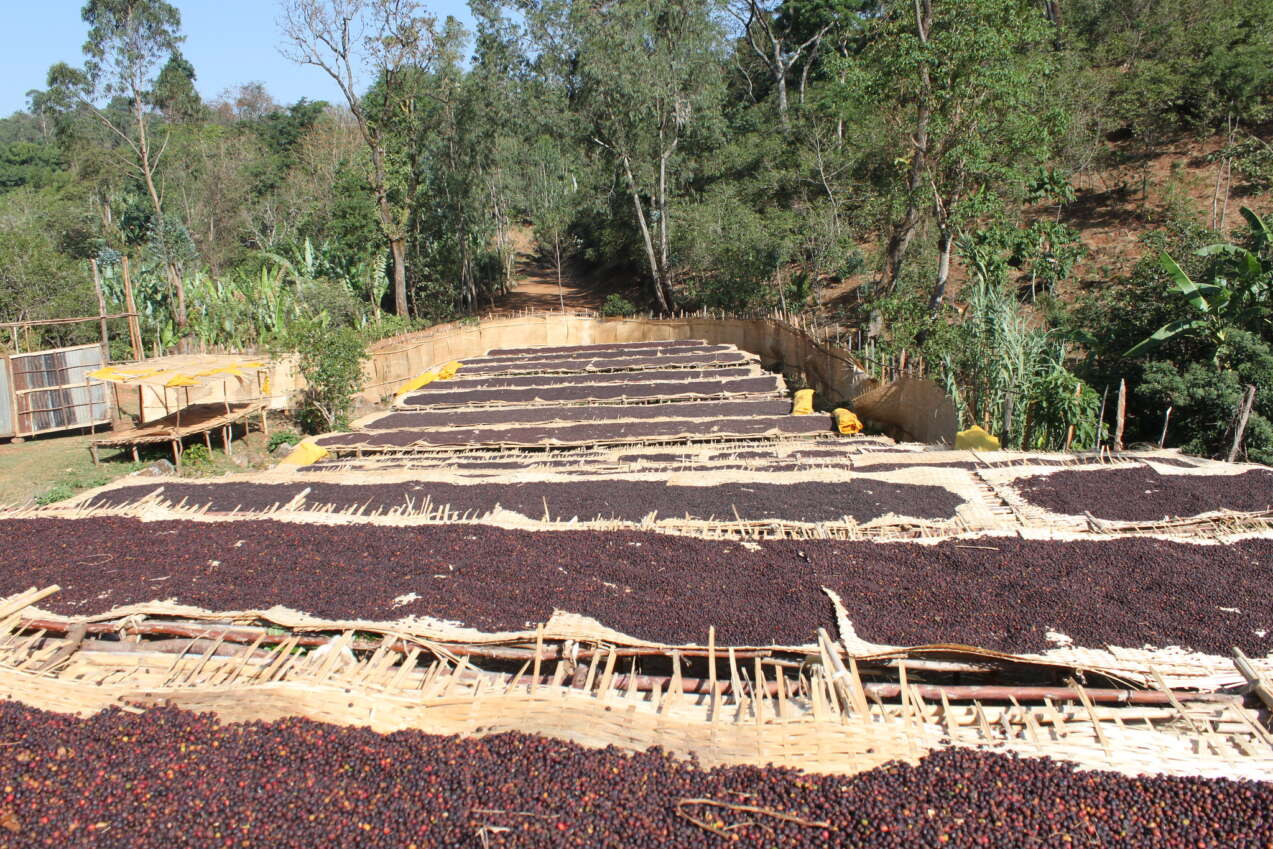Coffee Processing. Washed, Natural and Honey

Natural processing. This coffee is undergoing a drying process while still encased in its fruit. A closer examination reveals a colour contrast: the coffee at the forefront is a vivid red, indicating it has recently been harvested and awaits further sorting. Meanwhile, the coffee positioned towards the rear adopts a deeper shade of purple or burgundy, a testament to its exposure to several days of sun-drying.
Coffee processing methods.
The Impact on Taste.
The transformation of a lovely coffee cherry into the exquisite roasted beans in your cup is an interesting journey. After picking, what distinguishes a vibrant and fruity Ethiopian Yirgacheffe from a rich Sumatran Mandheling? Some of it is down to the different types of coffee processing techniques.
These techniques significantly shape the ultimate flavour profile of your coffee. By looking at the process of how coffee cherries are handled – from stripping the fruit flesh to the drying phase – you’ll gain insights into the delicate differences among various beans, helping you select coffees that chime with your flavour preferences.
Let’s explore the three primary coffee processing techniques: Natural, Washed, and Honey.
Natural Processing: Capturing the Bean’s Character
The natural processing approach involves drying the whole coffee cherries in their entirety under the sun, retaining all parts of the fruit (pulp, mucilage, and skin). This age-old, natural method enables the sugars and flavours of the fruit to permeate the beans, leading to a full bodied coffee” with sweetness and fruit-forward notes. Depending on the bean’s origin and the specifics of its processing, natural coffees may also offer wine-like or chocolatey nuances.
Yet, natural processing demands meticulous care and is labour-intensive. The cherries require regular turning to dry evenly and avoid rotting. Additionally, this method depends significantly on good weather, making it less suited for areas with high moisture levels.
Flavour Profile: Expect a rich cup with good sweetness, fruit-forward notes, and intricate nuances.
Washed (wET) Processing: Purity and Precision
The washed processing technique, or wet process, focuses on purity and acidity. In this method, the fruit flesh is mechanically removed soon after harvesting. The beans are then left to ferment in water to dissolve the remaining mucilage layer before being thoroughly washed and dried on raised platforms or patios.
This careful cleaning process largely eliminates some of the fruit sugars and flavours, yielding a crisper, more acidic coffee with a clean finish. Washed coffees excel in bringing out the bean’s natural floral and citrus characteristics, allowing the distinct qualities of its origin to stand out.
Flavour Profile: Anticipate a crisp and clean cup with marked acidity, floral and citrus undertones, and a smooth finish.

Washed Coffee Processing Ethiopia
Honey Processing: Finding the Perfect Balance
Positioned between the natural and washed techniques, the honey processing method retains some of the fruit flesh (mucilage) on the bean after pulping. The degree of mucilage left on the bean defines the “honey” category – from white honey (most mucilage) to yellow honey (medium) and black honey (least mucilage).
This approach allows for a bit of the fruit’s natural sweetness and flavours to enhance the beans, yet achieves a cleaner taste profile compared to the entirely natural method. Honey processed coffees are known for their harmonious balance, showcasing sweetness alongside the acidity of the beans.
Flavour Profile: Look for a harmonious cup with sweetness, noticeable acidity, fruity notes, and a smooth texture.
Less Common Processing Methods
Beyond these conventional methods, specialty coffee producers are ever experimenting. Innovative processing techniques such as anaerobic fermentation, carbonic maceration, and pulped natural drying are redefining flavour possibilities, introducing unconventional, wine-like qualities, or vivid fruitiness.
Selecting Coffees by Processing Technique
Knowledge of coffee processing techniques enables you to choose based on your flavour preferences confidently.
* If you’re drawn to sweetness and vivid fruit flavours, a natural processed coffee might be your choice.
* If you prefer risp acidity and floral notes, consider washed coffees.
* For a mix of sweetness and acidity, the honey processed coffees are worth exploring.
Coffee processing techniques are pivotal in developing the bean’s taste profile. Moving beyond the basic understanding of roasting allows you to explore the nuanced interplay of processing methods, bean origins, and roasting styles.


